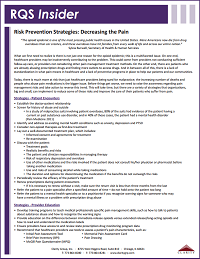Risk Prevention Strategies: Decreasing the Pain
“The opioid epidemic is one of the most pressing public health issues in the United States. More Americans now die from drug overdoses than car crashes, and these overdoses have hit families from every walk of life and across our entire nation.” Sylvia Burwell, Secretary of Health and Human Services
What we first need to realize is there is not just one reason for the opioid epidemic; this is a multifaceted issue that includes everyone from healthcare providers to patients and the industry as a whole. On one end, healthcare providers may be inadvertently contributing to the problem by not considering other treatment methods or by not laying out well-documented follow-up plans. On the other end, there are patients who are already abusing prescription drugs and who are finding more outlets to access drugs. And in between all of this, there is a lack of standardization in what pain means in healthcare and a lack of preventive programs in place to help our patients and our communities combat this issue.
In order to reverse this trend, healthcare providers need to take the first step and develop more comprehensive risk management strategies that involve prescription drug abuse. As part of our RQS Insider series, Clarity Group created a bulletin to aid providers in this process. This bulletin offers a variety of strategies that organizations, big and small, can implement to reduce some of the pain management risks and improve patient care.
